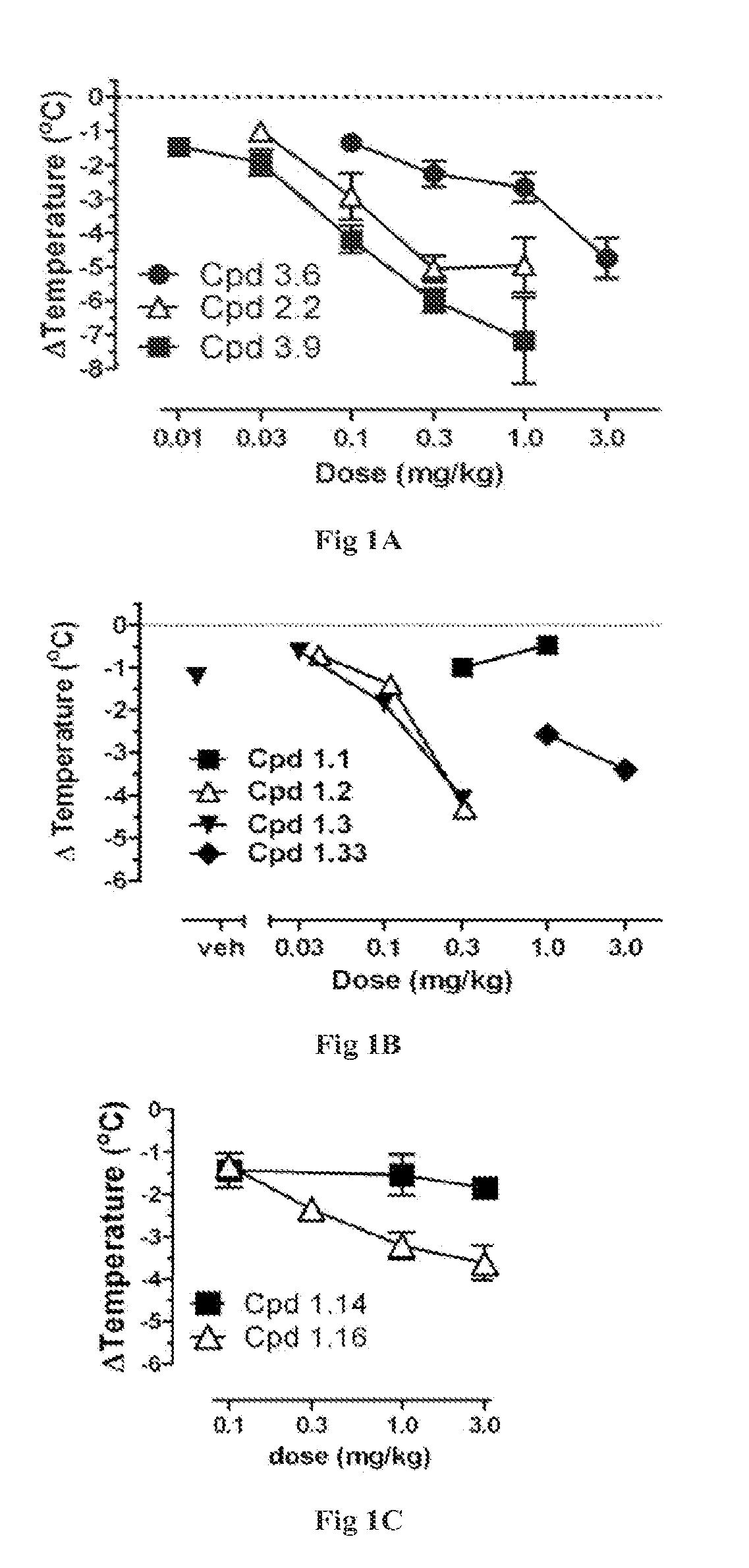Novel Cannabinergic Compounds And Uses Thereof
a cannabinol and compound technology, applied in the field of medical chemistry, can solve the problems of large volume distribution, high protein binding (97%), unpredictable magnitude and duration of in vivo cb1 and/or cb2 receptor modulation by many cannabinolrgic ligands such as dronabinol and nabilon
- Summary
- Abstract
- Description
- Claims
- Application Information
AI Technical Summary
Benefits of technology
Problems solved by technology
Method used
Image
Examples
example 1
Synthesis of Tricyclic Acid (1.1)
[0251]
[0252]Procedure:
[0253]2-(3, 5-dimethoxyphenyl)-2-methylpropanenitrile (1)
[0254]To the stirring suspension of sodium hydride (169.2 mmol) in dry DMF (40 ml) under argon at 0° C. was added drop wise a mixture of 3,5-dimethoxyphenylacetonitrile (56.2 mmol) and iodomethane (169.2 mmol) in dry DMF (40 ml). The reaction mixture was brought to room temperature after stirring at 0° C. for 15 min and stirred for additional 1.5 h. The reaction mixture was quenched with drop wise addition of saturated solution of NH4Cl and diluted with ether. The organic layer was separated and aqueous layer extracted with ether 3 times. The combined organic layers were collected, washed with saturated brine solution, dried over magnesium sulfate and concentrated under vacuum to get crude product which was then chromatographed on silica gel eluting with 25% ethyl acetate / hexane to yield compound 1 as colorless oil (11.01 g, 95% yield). 1H NMR (500 MHz, Chloroform-d) δ ppm...
example 2
Synthesis of Compounds 1.2, 1.3, 1.4, 1.5, 1.6, 1.7, 1.8, 1.9, 1.10, 1.24, 1.25, 1.34, 1.35, and 1.36
[0261]Tricyclic acid (1.1) was coupled with side chains using optimized microwave conditions to give respective compounds as shown in scheme 2 and 2a.
[0262]Typical Procedure
[0263]Alkyl side chain (1.5 equivalent) was added to the stirring mixture of 1.1 (1 equivalent) and sodium bicarbonate (1.5 equivalent) in dimethyl formamide (2 ml) in microwave vessel and the resulting solution was heated at 165° C. in microwave for 12 min. The reaction mixture was quenched with water and diluted with ethyl acetate. The organic layer separated and aqueous layer extracted 3 times with ethyl acetate. The combined organic layers were collected, washed with saturated brine, dried over magnesium sulfate and concentrated under vacuum to get crude product which was then chromatographed on silica gel to get pure product.
[0264]4-bromobutyl-2-((6aS,10aR)-6a,7,10,10a-tetrahydro-1-hydroxy-6,6,9-trimethyl-6H-...
example 3
Synthesis of Compounds 1.11, 1.12, 1.13, 1.14, 1.15, and 1.16
[0292]The synthesis of compounds with monomethyl at 1′ position is depicted in scheme 3, 3a and 3b.
[0293]Procedure
[0294]2-(3,5-dimethoxyphenyl)propanenitrile (4)
[0295]A solution of 3,5-dimethoxyphenylacetonitrile (28.2 mmoles) and iodomethane (42.3 mmoles) in dry DMF (30 ml) was added at 0° C. to a suspension of sodium hydride (33.8 mmoles, 60% dispersion in oil) in dry DMF (50 ml). The resulting mixture was brought to room temperature and stirred for additional 2 h. The reaction mixture was quenched with saturated ammonium chloride and diluted with ethyl acetate. The organic layer separated and aqueous layer extracted with ethyl acetate three times. The combined organic layers collected, washed with water, saturated brine solution and dried over magnesium sulfate silution to get crude product which is then chromatographed on silica gel eluting with 20% Ethyl acetate:Hexane mixture to get pure intermediate 4 (75% yield) as...
PUM
| Property | Measurement | Unit |
|---|---|---|
| temperature | aaaaa | aaaaa |
| temperature | aaaaa | aaaaa |
| temperature | aaaaa | aaaaa |
Abstract
Description
Claims
Application Information
 Login to View More
Login to View More - R&D
- Intellectual Property
- Life Sciences
- Materials
- Tech Scout
- Unparalleled Data Quality
- Higher Quality Content
- 60% Fewer Hallucinations
Browse by: Latest US Patents, China's latest patents, Technical Efficacy Thesaurus, Application Domain, Technology Topic, Popular Technical Reports.
© 2025 PatSnap. All rights reserved.Legal|Privacy policy|Modern Slavery Act Transparency Statement|Sitemap|About US| Contact US: help@patsnap.com



